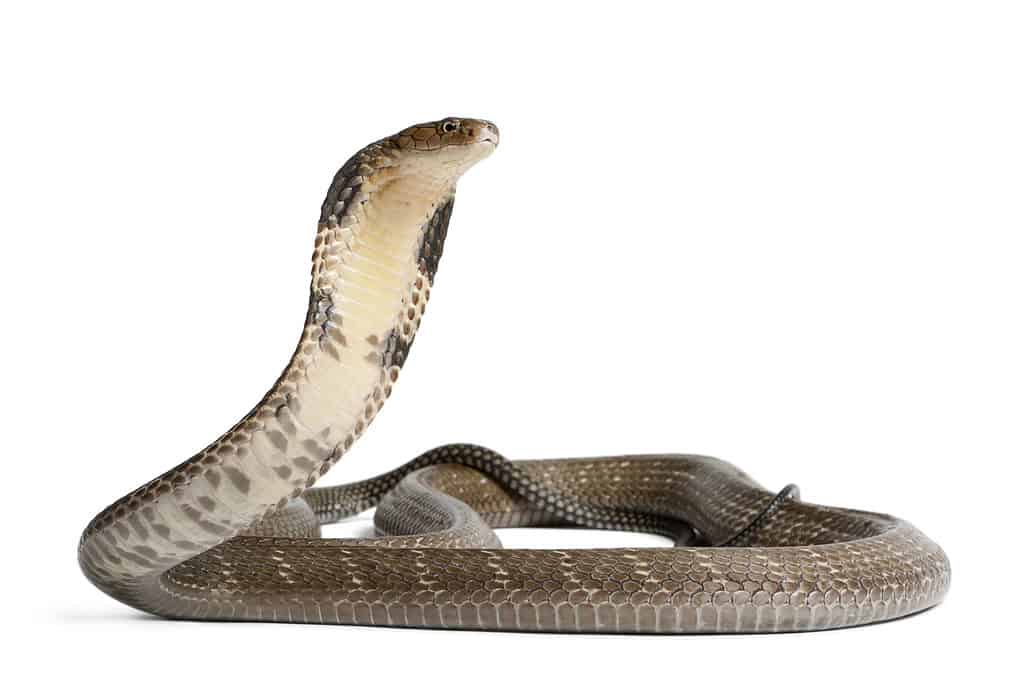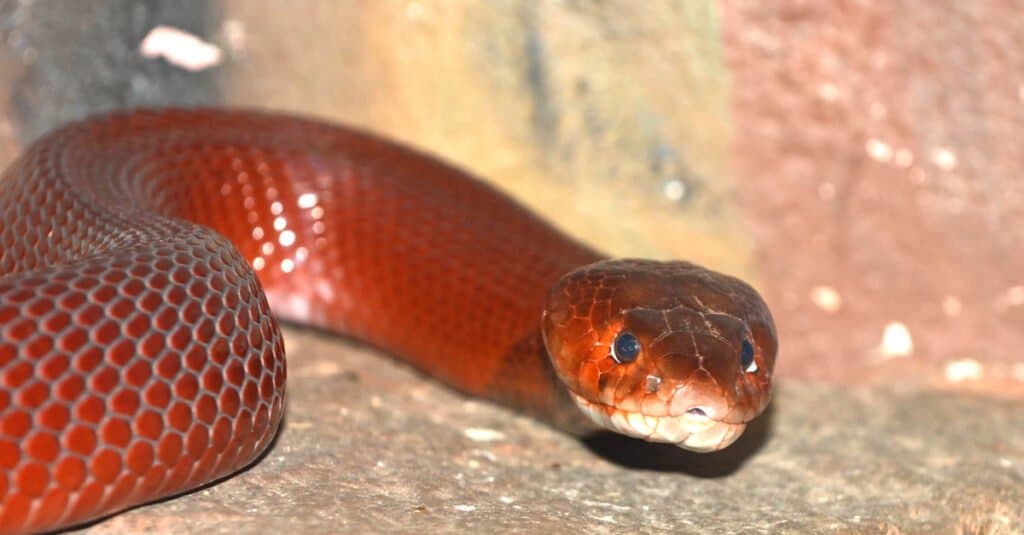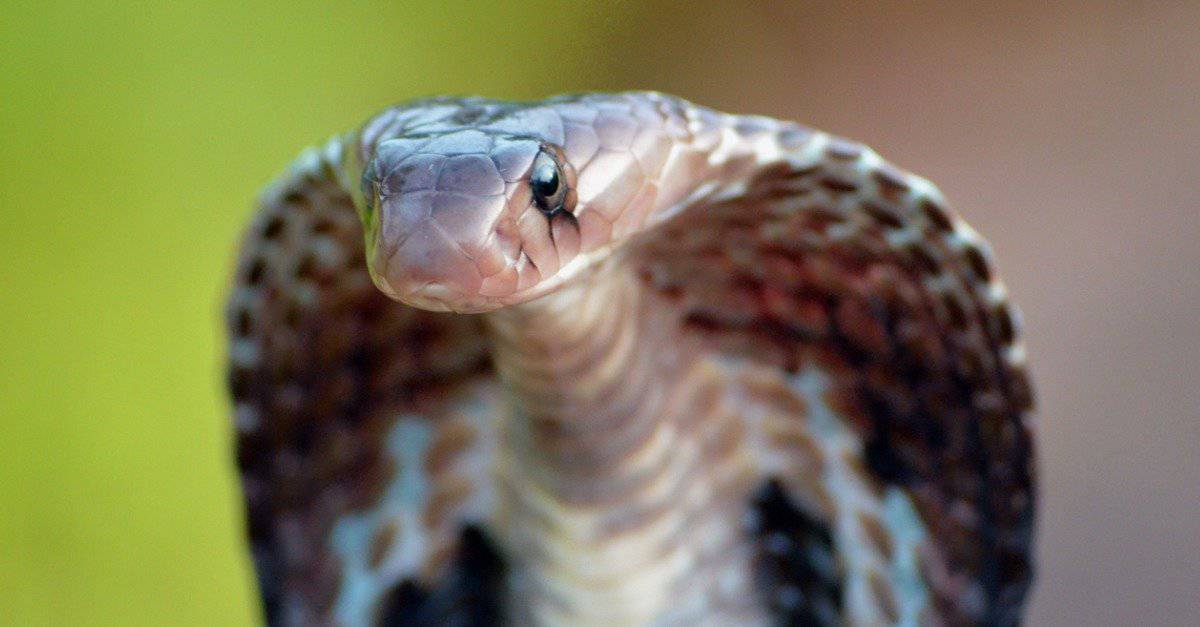When most people hear the word “cobra”, their minds wander to the slithering, hooded, and venomous snakes that live in the Indian subcontinent and Southeast Asia. We tend to fixate on the king cobra and its scary threat display and vast size. While they are certainly among the most dangerous cobras on the planet, they aren’t the only deadly cobras. Today, let’s take a look at some of the deadliest and most dangerous cobra species. We’ll show you the characteristics and traits of these snakes that make them so frightening.
What Are Cobras?

Most people know a cobra by its unique looks and behavior.
©RealityImages/Shutterstock.com
Cobras are elapid snakes from the Elapidae family, which includes coral snakes and sea snakes. They have hollow fangs located at the front of their mouth and are affixed to their top jaw. Typically, the term cobra refers to any elapid snake. Thus, cobra is a common name for snakes rather than a scientific one.
True cobras are snakes from the Naja genus, and most of the snakes we examine on this list belong to that family. One notable species that is not a member of the Naja family is the king cobra. Nevertheless, this iconic snake is often included in the discussion of cobra snakes.
Elapid snakes are all venomous snakes that can severely harm animals and people. They’re also known for their unique posturing before an attack. As part of their threat display, they will raise a portion of their bodies off the ground, rear back, and spread their necks out into hoods. If the creature gets too close after that, the snake will lunge at them, issuing a venomous bite.
Fortunately, not all bites contain venom. Cobras will deliver dry bites to get their enemies to leave them alone without wasting the venom they need to find food. If a person is bitten by any venomous snake, they need to seek medical assistance in case they were envenomated.
Examining The Most Dangerous and Deadly Cobras

Some cobras are more dangerous than others, but all cobras should be avoided.
©Mohammed younos/Shutterstock.com
Now that we know the things that set cobras apart from other snakes, let’s take a closer look at them. We are going to create some snake superlatives. By the time we’re done, you’ll know all about deadly cobras and which species are the worst to encounter.
Which Cobra Kills the Most People?

The large hood on the neck of the Indian cobra is marked with black and white.
©Dr. Meet Poddar/Shutterstock.com
The Indian cobra kills the most people out of any creature in the elapid snake family. This snake is known for being a member of the “Big 4”, the snakes that are responsible for killing the most people in the Indian subcontinent every year. Unfortunately, this part of the world is inundated with venomous snakes, so upwards of 50,000 people die from bites from those four snakes each year.
The Indian cobra has a mortality rate of between 6.5% and 20% for its bites, a very high rate when you consider the prevalence of antivenom in the world. Roughly 12% of all bites in India and the surrounding countries come from this snake. Some estimates say that the Indian cobra is responsible for about 15,000 deaths on its own, and it causes far more injuries than that.
What is the Most Venomous Cobra in the World?
The Caspian cobra is the most venomous cobra in the world. When we say most venomous, we mean that this snake is the one that has the deadliest venom of all its family members. This snake is recognized as extremely problematic because of the potent chemical cocktail that it introduces to its prey.
According to studies, this snake has the fifth-highest potential fatality count for a single maximum dose of venom of any snake that exists today. A single bite from this snake could effectively kill 42 humans by delivering 590mg of venom into their system.
Even though this snake has incredibly deadly venom, it’s not responsible for a high number of bites in its native range. Thus, it has the most potent venom, but it’s not the deadliest snake.
Which Cobra Injects the Most Venom?

Not only is the forest cobra the longest true cobra, but it’s incredibly deadly.
©NickEvansKZN/Shutterstock.com
The forest cobra has the largest potential venom injection of any member of the elapid family. The forest cobra can produce a massive dose of venom into its prey. This amount measures 1,102mg of venom, enough to kill 65 humans.
Although the cobra can kill more humans with a single bite than a Caspian cobra, it also injects about twice as much venom. When adjusting for the amount of venom, the Caspian cobra is deadlier than the forest cobra.
Nevertheless, the forest cobra injects the most venom of any of the elapids.
What is the Largest Cobra?

King cobra’s venom is strong enough to kill an
elephant
.
©Eric Isselee/Shutterstock.com
The king cobra is the largest cobra in the world. This snake can measure up to 13ft long, and some estimates say that the snake’s maximum length is about 19ft. That is quite a massive snake, especially when you consider that most snakes over 20ft are constrictors like pythons and anacondas.
However, the king cobra is not truly a member of the Naja family, meaning its not a “true” cobra. This king’s claim is tarnished by belonging to the wrong family! The largest species of true cobra is the forest cobra, a snake that can measure about 10ft at its longest.
One of these snakes is the longest cobra, true or not.
Which Deadly Cobra Can Spit Venom?

Spitting cobras are capable of spitting venom into their victims’ eyes.
©mountainpix/Shutterstock.com
Most cobra will sink their hollow fangs into their prey to deliver their deadly venom. However, several species of cobras spit their venom at their enemies to blind them. Spitting cobras may have actually evolved to specifically target the eyes of humans.
These snakes can accurately send a stream of venom from their fangs towards humans. That venom will cause significant damage to the eyes of their foes, even blinding them. Roughly 20 species of spitting cobras exist, and they can be found in Africa and Asia. Only some cobras can “spit” venom, and they can only do this because they have smaller openings on their fangs.
Cobras are a very interesting type of snake. They are instantly identifiable and highly dangerous. Now that you know about the deadly cobras and which of them are most hazardous to be around, you can continue to avoid them.
Discover the "Monster" Snake 5X Bigger than an Anaconda
Every day A-Z Animals sends out some of the most incredible facts in the world from our free newsletter. Want to discover the 10 most beautiful snakes in the world, a "snake island" where you're never more than 3 feet from danger, or a "monster" snake 5X larger than an anaconda? Then sign up right now and you'll start receiving our daily newsletter absolutely free.
Thank you for reading! Have some feedback for us? Contact the AZ Animals editorial team.








